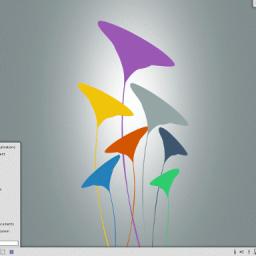
This Friday's distro is
KaOS Linux, and the K stands for KDE. But this isn't just a "lean KDE distro," as is their motto: the focus is quite a bit better defined even than that:
The idea behind KaOS is to create a tightly integrated rolling and transparent distribution for the modern desktop, built from scratch with a very specific focus.
Focus on one DE (KDE), one toolkit (Qt), one architecture (x86_64) plus a focus on evaluating and selecting the most suitable tools and applications. ... It targets users who have tried many Operating Systems/Distributions/Desktop Environments and have found they prefer a Distribution that uses all its available resources to work on one DE to make that the best it can be, and know that after their searches, the best for them is KDE.
The KaOS Linux website was my first reference point for familiarizing myself with this distro, but we're lucky in that it's recently gotten quite a bit of press, too. ZDNet looked at it and called it "
solid and focused: The reviewer wasn't thrilled with the installer but found it a reasonable package selections (that even transcends the "QT only" philosophy by also providing LibreOffice and GIMP). And
HecticGeek also gave it a spin, though the site was down as I write this.
For me, the killer decision point is really the choice of the Calligra office suite as primary productivity suite. And the fact that LibreOffice is in the repos tells me that it is still not totally baked as an office suite; too bad because I've always rooted for what was once called Koffice and would love to see it blossom, though it always seems to let me down: font kerning was still a mess the last time I tried it in 2012.
Anyway, the folks behind KaOS admit this distro isn't going to be for everyone. But for people that have tried the other options and decided on KDE, this is a distro that promises you that all its effort has gone into ensuring this KDE-centric distro gives you a great experience. I'm looking forward to giving it a whirl.

If you're never used
Trello before, I'd highly encourage you to do so. It's the equivalent of a digital whiteboard that allows teams to organize, collaborate, and collectively manage tasks. I discovered it in about 2011, set up a free Trello board for the team and project I manage, and have had no regrets at all: people love it, it's easy to use, and makes it easy to stay organized via tablet, phone, or desktop.
And now,
it's an independent company. The Wall Street Journal reports:
For the second time, Fog Creek Software Inc. has spun out a company-Trello Inc., an internal project management tool that became so popular, according to the founders, it needed to exist on its own. ... Trello takes with it $10.3 million in funding and follows a familiar path of companies that grew up around tools created somewhere else. Twitter Inc. started out as twttr, a short message service used internally by the podcasting company Odeo, while Yammer, acquired by Microsoft Corp. in 2012 for $1.2 billion, was an internal communications tool for the geneology website Geni.com. ...
"It reminds us of the early traction that Dropbox"and other apps up there had that have grabbed individuals and caused them to start using it and bring it to work and convince teams and colleagues to use it and it's gradually taken over organizations," said Index Partner Neil Rimer, whose brother Danny, also an Index partner, invested in Dropbox for that firm. "It turns out to be a better solution than the stuff at the top that's driven into the organization by policy."
That last comment is a not-very-veiled swipe at SharePoint, and it fits my experience perfectly: management requires it, even though it's almost totally useless for our purposes.
Joel Spolsky, co-founder of Fog Creek Software, tells the story beautifully over at the company blog. Clearly, there's still tons of money to be made simply by creating things that help people accomplish things more efficiently. As an avid Trello advocate, I'm raising a glass to these guys [and hoping under the new arrangement corporate ownership doesn't screw the pooch or raise prices, etc.]
Someone over at the US House of Representatives - or maybe a group of someones - has made such a nuisance editing Wikipedia that
Wikipedia's administration has applied a ten day ban on all anonymous edits at the site. What precipitated the ban was not edits to articles about jam bands and their fans' favorite foods, but rather a series of more creative edits that suggested that, among other things, Cuban spies orchestrated the assassination of JFK and a race of hyper-intelligent extra-terrestrial lizardmen has infiltrated the U.S. government, Mediaite said. ... ome staffers are upset about the ban and took to Wikipedia to complain. "Out of over 9000 staffers in the House, should we really be banning this whole IP range based on the actions of two or three? Some of use here are just making grammatical edits, adding information about birds in Omsk, or showing how one can patch KDE2 under FreeBSD," said one staffer from the House's IP address.
Important take-away conclusions from this article:
1. House Representatives or their staffers are spending way too much time on Wikipedia.
2. The Twitterbot and Wikipedia oversight have been useful and shed light on what's going on.
But most importantly:
3. Holy crap: the House of Reps is running KDE2 on FreeBSD!
Everyone knows opinions are like noses: everyone has one. But Bruce Byfield has been at it longer than most, and his opinion often reflects the industry. And he loves KDE5.
At a time when the Linux desktop offers six main alternatives (Cinnamon, GNOME, KDE Plasma, LXDE, Mate, Unity and Xfce), KDE Plasma consistently tops reader polls with an average of 35-40 percent. In such a diverse market, these figures indicate a broad appeal that other Linux desktop alternatives can't match.
I believe that one of the main reasons for this appeal is the KDE design philosophy. GNOME and Unity may offer a more aesthetic-looking default, but only at the cost of simplifying both the desktop and the utilities in the name of reducing clutter.
By contrast, KDE goes to the opposite extreme. KDE applications typically include every function you can imagine. Sometimes, they can take a version or two to organize the menus in a meaningful way, but applications like Amarok, K3B, or digiKam go far beyond the most common use cases. When you run into problems with them, they usually offer solutions.
Read the rest of his thoughtful and insightful review here.
[Ed. note: Actually, opinions are like something else. But Pipedot is a family-friendly site.]

The relationship among Microsoft, Intel, and ARM remains so intricate it's keeping analysts busy full time trying to deduce what will happen next.
There's good reason to believe Intel's new Bay Trail chips provide performance and energy consumption that's not quite at ARM levels but that do permit Microsoft to hedge its bets by staying with the Intel chips its software seems to require, and ditch ARM altogether. But on the smartphone side, things aren't as clear and there, Qualcomm's ARM chips remain really the leader for mobile computing and an important part of most vendors' strategies.
When Intel lacked competitive low-power mobile system-on-a-chip, or SoC, products, it made sense for Microsoft to want to hedge its bets. After all, if Intel couldn't or wouldn't deliver, then Microsoft's tablet ambitions would crumble. However, when Intel launched its first low-power SoC for tablets -- known as Clover Trail -- it was actually a pretty decent chip. Graphics performance was terrible, but the general-purpose performance was quite a bit better than the Tegra 3 in the Surface RT. Intel's next-generation product, Bay Trail, was more competitive, offering leadership CPU performance and fairly decent graphics performance. The graphics performance of the Tegra 4 found inside of the Surface 2 was still better than Bay Trail's, but the delta wasn't so large as to make the Intel chip look laughable.
That doesn't necessarily mean happy days for Intel. In fact, ExtremeTech believes Intel forcing its way into mobile computing may destroy Intel from the inside out.Fast forward to the present day, and the market Intel is fighting to enter has changed more rapidly than Chipzilla anticipated. Intel chose to stick with dual-core with Hyper-Threading while the ARM SoCs jumped to quad-core. It chose to keep its modem manufacturing at TSMC, where it has faced repeated, unspecified delays. For all that Intel leads the world in semiconductor manufacturing, its XMM 7160 (that's the company's 4G modem actually shipping in any consumer hardware) is built on 40nm, while Qualcomm's Gobi 9i-35 platform is sitting on 20nm.
Stay tuned.
Yes, Android is based on the Linux kernel, but until the Linux and Android platforms and application ecosystems have been separate things.
MicroXwin hopes to change that with a new Linux distro called VolksPC that runs both Debian and Android apps in fully native mode.
"We created a unified distribution that allows both Android and Debian LXDE/XFCE applications to run simultaneously at native speeds. On ARM, our distribution is based on a modified ARMHF Debian Wheezy rootfs", the developers write. As Phoronix reports, the developers claim that apps under both environments run "at native speeds"; the only changes to Android are in startup scripts, providing full compatibility with existing applications; and MicroXwin provides a high-speed X-Windows framework for the system.
The distro hopes to provide the best of both worlds, and a Linux desktop environment with full support for the entire Debian app repository while providing Android's simplicity and ease of use where things like HD video are concerned.

Serious gamers look to dedicated hardware and serious firepower for their gaming experience, but the casual gamer turns to the web, and probably has to start by downloading and installing a plug-in first. That turns a lot of gamers off, and
Mozilla hopes to do something about it. Says TechCrunch:
For the longest time, web-based gaming meant that you had to install (often dubious) plugins to make games run smoothly in your browser. WebGL and other technologies changed that a bit in recent years, but because JavaScript isn't exactly a speed freak, plugin-free gaming never quite took off. Mozilla has been trying to work around this with asm.js, a subset of JavaScript that can run extremely fast in Firefox and today, the organization announced that the first commercial 3D game based on asm.js is about to launch.
That game is
Dungeon Defenders Eternity, playable on the desktop via Steam, or on the web at
playverse.com. A mix of tower defense and role playing styles, looks like a a fun game first, but a good test of a new technology as well. Mozilla's ASM.js may not be revolutionary, but it does stand a chance at improving the ease with which the casual gamer can simply start up a game on the web without needing to worry about downloading and installing a plug-in.
The downing of Malaysia Airline MH17 in the Ukraine is turning out to be one of the biggest of tragedies of 2014 and we don't have all the answers yet.
Here is a look at some of the technologies being used to unravel the mystery. From infrared to satellite imagery to chemical signatures, it's all being used to get answers. And don't rule out human technology either: eyewitnesses make the list of forensic strategies as well.
The most important element in instilling similar certainty among European partners will probably be infrared satellite imagery. The National Reconnaissance Office, or NRO, and the Air Force Space Command operate a number of infrared satellites, such as the Space Based Infrared System (SBIRS). There are currently two SBIRS satellites in orbit but there will be six by 2022, with Lockheed Martin as developer, under control of Air Force Space Command.
Courtesy of the
National Journal.

It's old news, but it's only being reported today: turns out, in 2010, Russian crackers exploited a zero-day vulnerability to install some malware on the Nasdaq stock exchange systems capable of derailing the stock exchange.
The October alert prompted the involvement of the National Security Agency, and just into 2011, the NSA concluded there was a significant danger. ... [The] National Cybersecurity and Communications Integration Center (NCCIC), whose mission is to spot and coordinate the government's response to digital attacks on the U.S. ... reviewed the FBI data and additional information from the NSA, and quickly concluded they needed to escalate. Thus began a frenzied five-month investigation that would test the cyber-response capabilities of the U.S. and directly involve the president. Intelligence and law enforcement agencies, under pressure to decipher a complex hack, struggled to provide an even moderately clear picture to policymakers. After months of work, there were still basic disagreements in different parts of government over who was behind the incident and why.
Bloomberg Businessweek does an excellent job of telling the story of competing security agencies, their different mandates, and how they cooperated and sometimes competed to deal with the intrusion.The agents found little evidence of a broader attack. What they did find were systematic security failures riddling some of the most important U.S. financial institutions. It turned out that many on the list were vulnerable to the same attack that struck Nasdaq. They were spared only because the hackers hadn't bothered to try.
Our Monday poll is up, and it involves choice of programming languages in order to stay hire-able in a moving market.
Look 5-10 years into the future and give us the advice you'd give your son/daughter headed to an expensive university to learn computer programming. That doesn't mean: what
language do you need to learn to get that job? It means: what
languages (plural!) would not only facilitate employment but also provide a balanced understanding of systems and processes and even perhaps set the stage for learning and understanding other things? You might recommend Ruby for example, knowing full well that Ruby won't exist in 2019 but its likely successor will require a programmer to understand its origins in Ruby choices, for example.
This is an
Approval Count poll, so you can - and should! - choose all or any of the languages you'd recommend. Obviously this list couldn't have been exhaustive, so if I've missed your favorite,
add it into the comments.
 This Friday's distro is KaOS Linux, and the K stands for KDE. But this isn't just a "lean KDE distro," as is their motto: the focus is quite a bit better defined even than that:
This Friday's distro is KaOS Linux, and the K stands for KDE. But this isn't just a "lean KDE distro," as is their motto: the focus is quite a bit better defined even than that:


